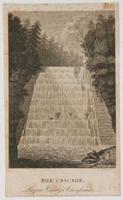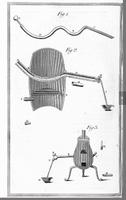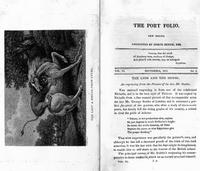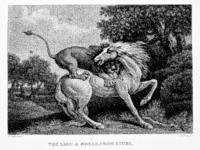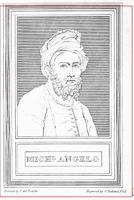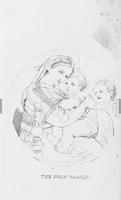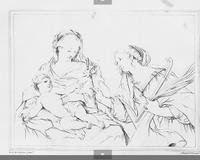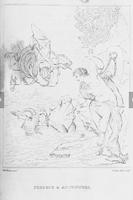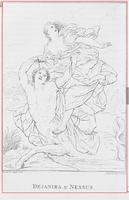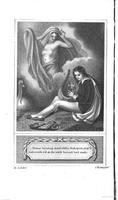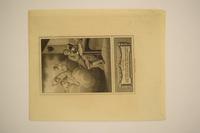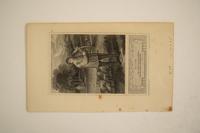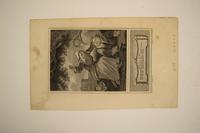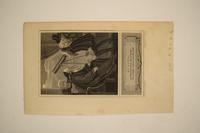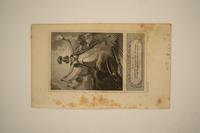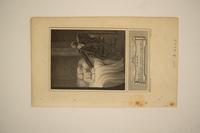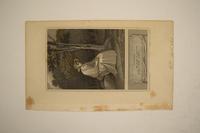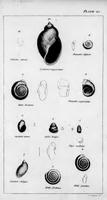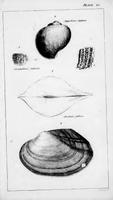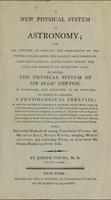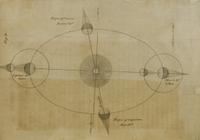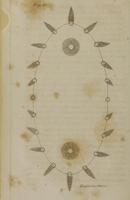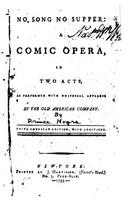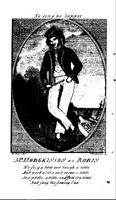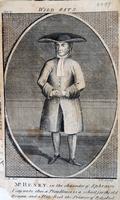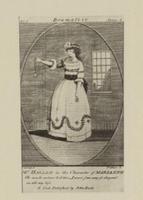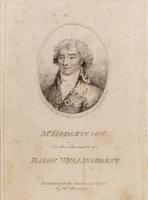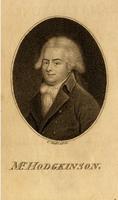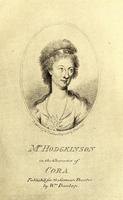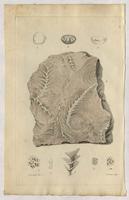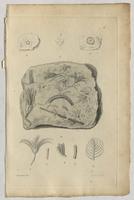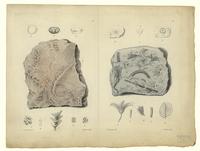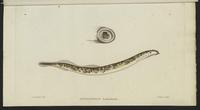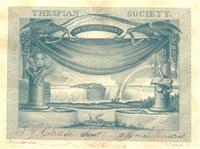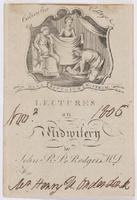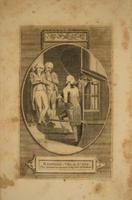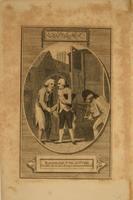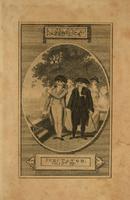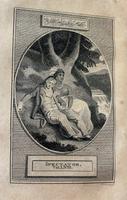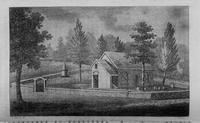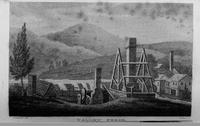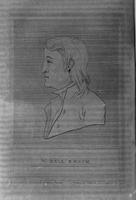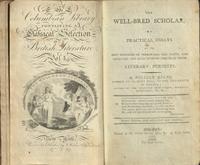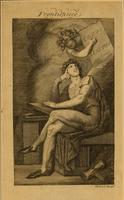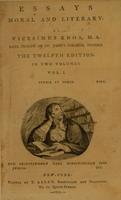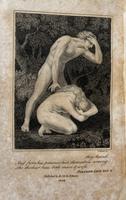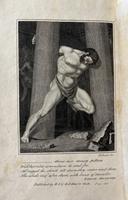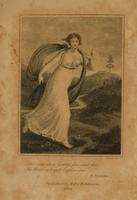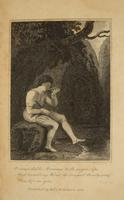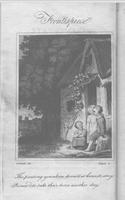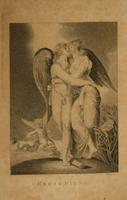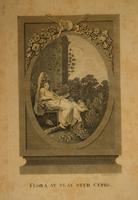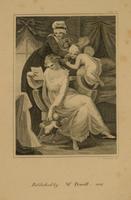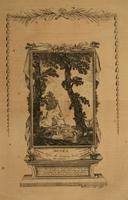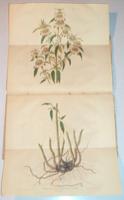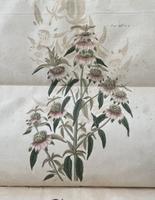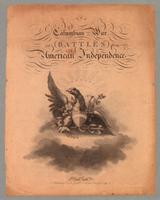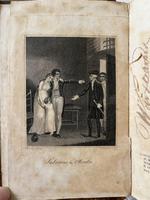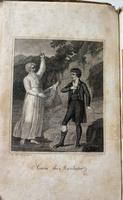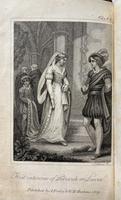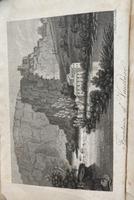Part 18. Miscellany
18.1 The Port Folio magazine
The significance for engravers of this magazine is discussed by Donald C. O'Brien, in "The Engravers of Philadelphia's Port Folio Magazine", Printing History, vol. 15, January 2014, pp. 3-31. A shorter account is given by Wikipedia, and many monthly issues can be read at Hathitrust.
In volume 4, 1910, The Port Folio has an article headed with the words "The Pennsylvania Academy of the Fine Arts" (PAFA), in which the following paragraph and footnote are of interest:
After the oration, some of the most distinguished members of the Society of Artists were admitted to fellowships, in the academy, and received their diplomas from the hands of George Clymer, esquire; the President. This ceremony was witnessed with much satisfaction, not only because it exhibited the Academy as already the patroness of native genius, but because it presented thus conspicuously to public notice, so many of our meritorious artists. The names of the gentlemen on whom this honour was conferred are: Wm. Rush, Thomas Sully, James Peale, Geo. Murray, Benjamin Tanner, John Vallance, Edward Miles, John I [James] Barralet, Moritz Furst, D. A. Volozan, Thos. Birch, Robt. Miles, Alex. Lawson, Cornelius Tiebout, David Edwin, John Dorsey, John Reisch, B. H. Latrobe (Washington), G. Jairman, A. Anderson (New York), W. S. Leney (New York).Ten Cornelius Tiebout engravings were published in The Port Folio; some of them show "FSA" (Fellow of the Society of Artists) after his signature. The engravings are listed here in the order of appearance in the carousel below:
1. The Cascade, March 1809, p. 232
2. Cottage Scene, April 1810, p. 265
3. Apparatus for distilling potassium, August 1811, pp. 144-152; 581-584
4. Lion & Horse, September 1811, pp. 200-203
5. Michl. Angelo, February 1812, p. 134
6. The Holy Family, March 1812, p. 256
7. St. Catharine presenting a lily to Jesus, April 1812, p. 360
8. Perseus & Andromeda, May 1812, p. 468
9. Dejanira & Nessus, July 1812. p. 72
10. Specimen of An Improved Method Of Engraving Bank Notes, December 1815, p. 308
(1) "The Cascade" in Luzerne County, Pennsylvania, is now in Susquehanna County, which was removed from Luzerne County the year after "The Cascade" appeared in The Port Folio. Under the caption "Falls of Cascade Creek", much the same engraving and accompanying text appeared in the Philadelphia Casket, November 1828, and again in History of Susquehanna County, pp. 88-89.
(2) "Cottage Scene" is of special interest, as indicated by the following two images:
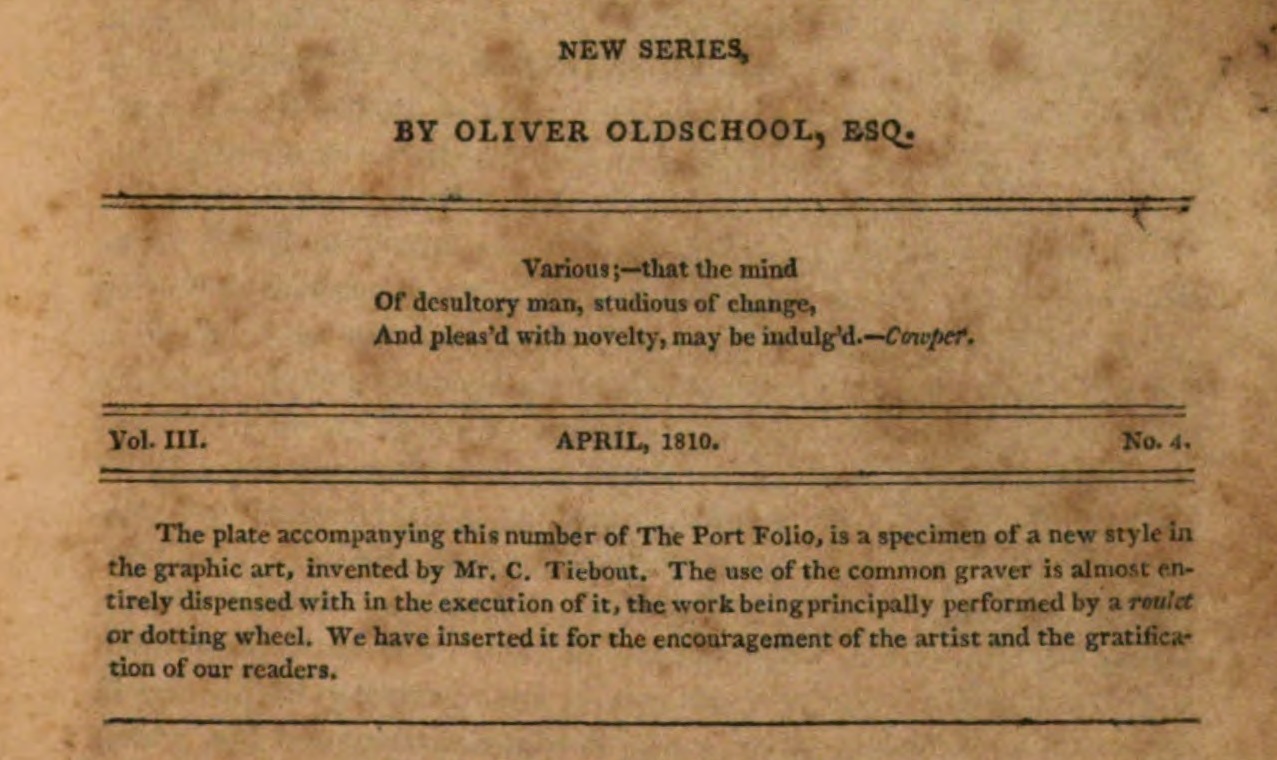
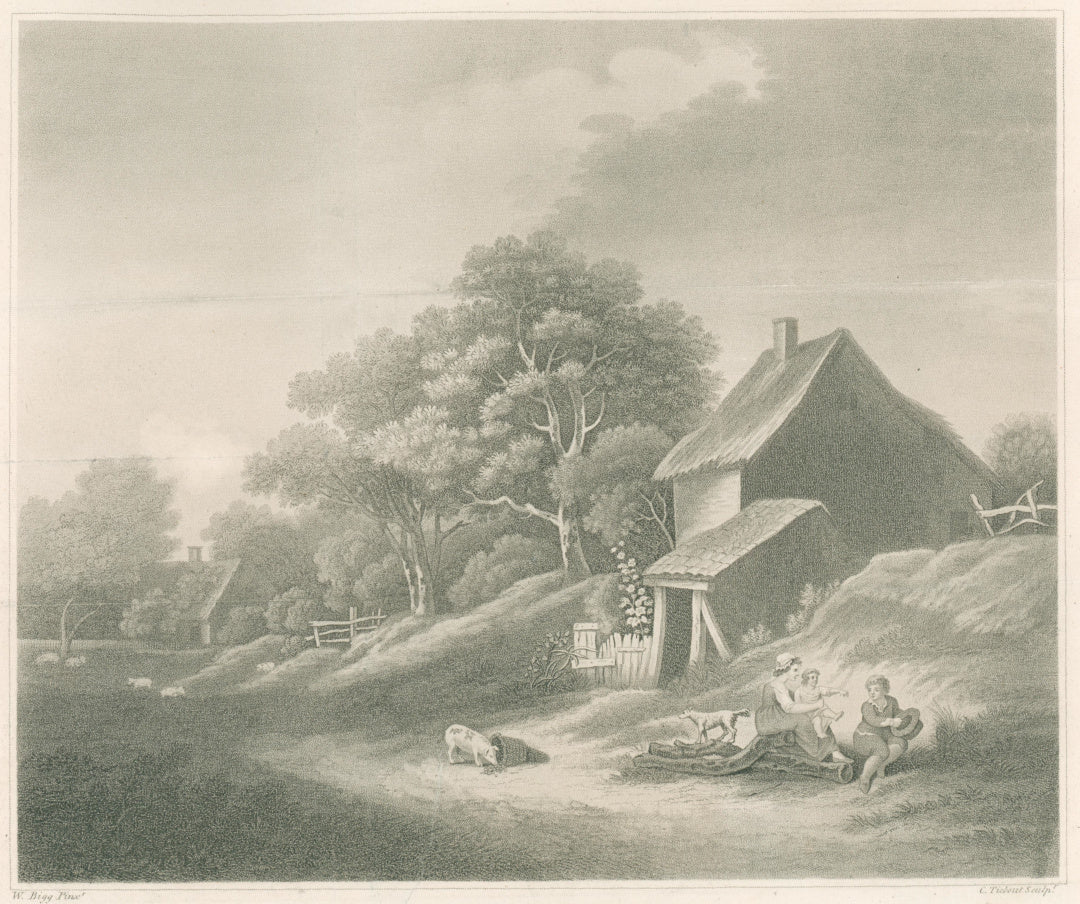
(3) Following Tiebout's engraving of "Apparatus for distilling potassium" is an Extract of a letter from Judge Cooper of Northumberland to Dr. Manners of this city [Philadelphia]. The letter begins thus: "About a fortnight ago, Mr. Reuben Haines of Philadelphia, brought me a few small pieces of Potassium, which Mr. W. Hembell was so kind as to send me; he procured them from Mr. Johns, who had repeatedly made it, as I understand, at Mr. Davy's laboratory at the Royal Institute in London…". The article provoked a response (pp. 551-584) from William Johns, Fellow of the Royal College of Surgeons, London. His letter is captioned Strictures on Judge Cooper's Letter to Dr. Manners.
(4) "Lion & Horse" is after a painting by George Stubbs (1724-1806). Like many artists whose works Tiebout engraved, Stubbs painted more than one image using the same theme. The first of sixteen paintings of A Lion Attacking a Horse can be viewed at the Yale Center For British Art.
(5) Tiebout's engraving of Michelangelo (1475-1564) is after Sebastiano del Piombo (1485?-1547), who collaborated with Michelangelo and was one of the few artists who got along with him. See portrait of Michelangelo attributed to del Piomba.
(6) Tiebout's engraving, "The Holy Family", is after the famous painting Madonna della Seggiola, by Raphael (1483-1520). The three figures represent Mary, Jesus, and the infant John the Baptist.
(7) This engraving, after Pietro da Cartona (1596?-1669), shows St. Catharine presenting a lily to Jesus in Mary's arms.
(8) Here, Andromeda is tethered to a rock, and Perseus is flying toward her while fighting a sea monster, after Paolo Veronese (1528-1588).
(9) The centaur Nessus is shown carrying Delanira across the river Evena; after Guido Reni (1575-1642).
(10) Along with the image of this specimen is an article captioned "Messrs. Tanner, Kearney and Tiebout's Improved Method of Engraving Bank Notes". This caption refers to Benjamin Tanner (1775-1848), a prolific engraver, who, according to some accounts, learned engraving from Cornelius Tiebout. The article opens with this paragraph:
No branch of engraving is of more importance than that of bank notes, the public interest being materially concerned in having them executed in the manner best calculated to prevent imitation. We are, therefore, much pleased to be enabled to present our readers, in this number, with a specimen of bank note ornaments, executed in a manner entirely new, which it is believed will very much increase the difficulies of counterfeiting. This is the invention of Mr. H. S. Tanner of Philadelphia, for which he has lately secured a patent.The inventor mentioned was Henry Schenck Tanner (1786-1858), who learned engraving from his brother, Benjamin Tanner. For details about the bank note firm of Tanner, Kearney and Tiebout, see article 18.5 below.
18.2 Cornelius Tiebout engravings in The Works of the British Poets
During 1819-1823, the fifty-volume collection, The Works of the British Poets: With Lives of the Authors, was published by Ezekiel Sanford (1796-1822) and Robert Walsh (1784-1859) in Philadelphia by the firm of Mitchell, Ames, and White. The volumes are available online: Hathitrust. Frontispieces engraved by Tiebout are listed here:
| Volume | Title (summary) | Artist |
|---|---|---|
| 3 | Nature Listening Stood&ellip; (youth with lyre; Nature in cloud) | Richard Cook |
| 4 | Donne (man in study with muses in clouds) | - |
| 7 | Milton (boy sharpening sythe; rustic background) | Richard Westall |
| 8 | Milton Composing Paradise Lost (large image just below) | Richard Westall |
| 9 | Butler (woman beating fallen man) | Henry Singleton |
| 10 | Butler (five men with telescope) | Henry Singleton |
| 13 | Smith (woman with torch, drummer, angels with trumpets, weapons) | Henry Singleton |
| 31 | Shaw (dying woman in bed, grieving man seated) | Richard Westall |
| 37 | Cowper (seated woman beside tree) | Richard Westall |
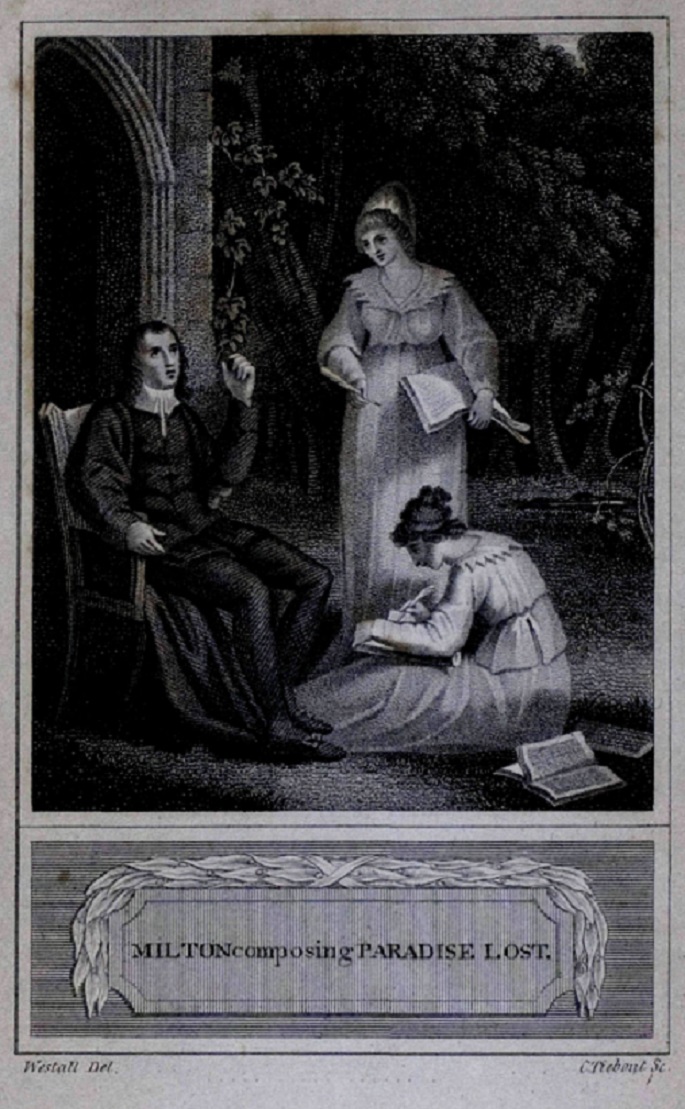
Richard Westall, Milton dictating to his daughters; viewable here:
Sir John Soane's Museum Collection Online.
18.3 Keating's Narrative of an Expedition
In 1824, H. C. Carey & I. Lea, successors of Mathew Carey, who had published many Tiebout engravings, published the following book by William H. Keating (1799-1840): Narrative of an Expedition to the Source of St. Peter's River, Lake Winnepeek, Lake of the Woods, &c. &c.: Performed in the Year 1823, by order of the Hon. J. C. Calhoun, Secretary of War, under the Command of Stephen H. Long, Major U.S.T.E., in two volumes. Tiebout's two engravings for the book are both in volume 2: plate 13 (10 shells) and plate 14 (4 shells).18.4 Joseph Young's System of Astronomy
Tiebout's wife's uncle, Dr. Joseph Young, was the author of an unusual book: A New Physical System of Astronomy; or, An Attempt to Explain the Operations of the Powers which Impel the Planets and Comets to Perform Eliptical Revolutions Round the Sun, and Revolve on Their Own Axis: in which, the Physical System of Sir Isaac Newton, is Examined, and Presumed to be Refuted. : To which is Annexed, a Physiological Treatise;…, published beginning in 1809 in New York. The carousel below shows the title page and Tiebout's two engravings. For more about Tiebout-Young family connections, see article 18.14 below.18.5 Banknotes
The Philadelphia banknote firm of Tanner, Kearney & Tiebout (TKT) existed during 1817-1824. Its principals were Benjamin Tanner, his younger brother Henry S. Tanner (mentioned above in article 18.1 paragraph (10)), Frances Kearney (surname often spelled K-e-a-r-n-y), and C. Tiebout. The most widely circulated issue from the firm is probably the sample shown in the carousel below. A related advertisement on the front page of the Nashville Whig, and Tennessee Advertiser, 9 May 1818, is reproduced here:

in The Nashville Whig,
and Tennessee Advertiser.
Images of several TKT banknotes appear below. Others can be found by searching American Numismatic Society, or, specifically, American Numismatic Society: Tiebout, and Newman Numismatic Portal Library (Washington University, St. Louis). A source for TKT banknotes on the Schulkill Bank is the Library of Congress.
For a background on copperplate engraving of banknotes, see Chapter VII, Bank Notes, in Donald C. O'Brien, Amos Doolittle: Engraver of the New Republic (Oak Knoll Press, The American Historical Print Collectors Society, 2008, pp. 57-63).
18.6 Plays published and performed in New York
(1) No Song, No Supper, by libretto by Prince Hoare (1755-1834), music by Stephen Storace (1762-1796). First performed in London in 1790, this comic opera was published by J. Harrison, New York, 3rd American edition, 1793. Tiebout's frontispiece, after W. Barr, shows actor John Hodgkinson as Robin. See Wikipedia: No Song, No Supper(2) Wild Oats; or, The Strolling Gentleman, by Irish playwright John O'Keeffe (1747-1833), a farce published by T. and J. Swords, New York, 1793. Tiebout's frontispiece shows actor John Henry as Ephraim Smooth, a Quaker. See Wikipedia: Wild Oats
(3) The Dramatist; or, Stop Him Who Can!, a comedy by Frederic Reynolds (1764-1841), published by T. and J. Swords, New York, 1793. Tiebout's frontispiece, after William Dunlap (1766-1839), shows Tiebout's engraving of actress Mrs. Eliza (Tukes) Hallam as Marianne.
(4) The Wild-goose Chace, a comedy by August von Kotzebue (1761-1819), translated from German, published by William Dunlap, New York, 1800. Tiebout's frontispiece, after William Dunlap, shows Tiebout's engraving of actor John Hodgkinson as Baron Wellinghorst.
(5) The East Indian, a comedy by August von Kotzebue, translated from German, published by Charles Smith and S. Stephens, New York, 1800. Tiebout's frontispiece shows actor John Hodgkinson.
(6) Pizarro in Peru, or, The Death of Rolla, a play in five acts by August von Kotzebue, translated from German, published by G. F. Hopkins for William Dunlap, New York, 1800. Tiebout's frontispiece shows actress Mrs. Melmoth. Listed only as "Melmoth" on the program for the first American performance at the New York Theatre on 26 March 26, 1800, the actress was Charlotte Melmoth. The artist, William Dunlap, was a leading theatrical producer. (7) The Virgin of the Sun, a play in five acts by August von Kotzebue, translated from German, published by G. F. Hopkins for William Dunlap, New York, 1800. Tiebout's frontispiece, after William Dunlap, shows actress Frances Brett Hodgkinson.
Among the leading early American actors and actresses in these plays were the Hodgkinsons and Hallams. For details, see Billy J. Harbin,"The Role of Mrs. Hallam in the Hodgkinson-Hallam Controversy: 1794-1797" (JSTOR) from Theatre Journal, vol. 32, no. 2, May 1980, pp. 213-222.
18.7 Lesueur: Engravings of fossils and a lamprey
The carousel below includes three drawings by Charles Alexandre Lesueur (1778-1846), preserved in the Muséum d’histoire naturelle, Le Havre, France. Cornelius Tiebout engraved these drawings during the years that both he and Lesueur lived in New Harmony, Indiana.
(1) Archimedes fossil. This genotype was named by David Dale Owen in 1838. See Archimedes and W. H. Easton and Helen Duncan, "Archimedes and Its Genotype", Journal of Paleontology vol. 27, no.5, September 1953, pp. 737-741, viewable online: JSTOR.
(2) (identification of fossil to be determined)
(3) Fossils (1) and (2) together, a high-resolution image. It appears that these fossils did not appear in any of Lesueur's publications.
(4) Petromison Lamonttenii, a species of lamprey. This illustration was published in Lesueur's American Ichthyology at "Maclure's Press" in New Harmony, 1827. You can read this rare book here: Internet Archive.
See article 18.8 for another Tiebout engraving of a Lesueur drawing.
18.8 Tickets
During Tiebout's lifetime, it was common for tickets for events (as well as menus, greeting cards, permits, awards, etc.) to be engraved. At least two tickets engraved by Cornelius Tiebout are known:(1) Thespian Society, drawn by Lesueur and engraved by Tiebout. Richard Owen (1810-1890 ) of New Harmony—brother of previously mentioned David Dale Owen and honorary first president of Purdue University—described the Lesueur-Tiebout ticket with these words:
It represented the Falls of Niagara, and to heighten the Americanism of the scene he painted by the side of the Falls that other great wonder of the New World, the rattlesnake. (From his article in Popular Science Monthly).The men T. G. Chase and John Schnee whose names are handwritten on the ticket are identified in online publications: Linda Warrum, "The Chase for Clorion", Indiana Magazine of History, vol. 109, no. 2, June 2013, pp. 147-160: Indiana Magazine of History (JSTOR)) and Nora C. Fretageot and W. V. Mangrum: Historic New Harmony: Official Guide, 1914.
(2) Lectures on Midwifery, by John R. B. Rodgers, at Columbia College. Rodgers was a professor at Columbia College (now Columbia University). The name handwritten on the ticket is that of the second bishop of the Episcopal diocese of Pennsylvania, who was a graduate of Columbia College: Henry U. Onderdonk.
18.9 The Rambler and The Spectator
These two periodicals were both published in Philadelphia in 1803. Both were copied from much earlier British publications of the same names. In The Rambler, Tiebout's engraving of a man alighting from a sedan chair is in vol. 3, and his engraving of men shaking hands appears in vol. 4. In The Spectator, vol. 1 includes both of Tiebout's engravings: (1) two men in a park by a river, one tossing a watch over his shoulder, and (2) a woman holding a man seated near a waterfall.18.10 Freemason's Magazine and General Miscellany
Shown below are three engravings after William Strickland (1788-1854):(1) Radnor Church with monument to General Anthony Wayne, Chester County, Pennsylvania, published in vol. 1, September 1811. See Radnor Church records.
(2) Valley Forge, published in vol. 2, October 1812. See Wikipedia.
(3) William Ball, R. W. G. P. M., published in vol. 1, May, 1811. Signatures at the bottom show "Ruling by Tiebout" and [engraving by] (William) Kneass, who became Chief Engraver of the U. S. Mint. The initials R.W.G.P.M. abbreviate Right Worshipful Past Grand Master. William Ball (1729-1810), a goldsmith, was one of the wealthiest citizens of Philadelphia. See Wayne A. Huss, The Master Builders: A History of the Grand Lodge of Free and Accepted Masons of Pennsylvania, vol. III, Grand Master Biographies, Philadelphia, 1986.
18.11 The Well-Bred Scholar
The carousel below shows Tiebout's frontispiece for William Milns's The Well-Bred Scholar, or Practical Essays on the Best Methods of Improving the Taste, and Assisting the Exertions of Youth in Their Literary Pursuits, published at the Literary Printing Office, No. 29 Gold Street, New York, 1797. The engraving is after a painting by Elkanah Tisdale (1768-1835).18.12 Young man and his genius
This frontispiece of Johann Casper Lavater's Aphorisms on Man (New York, 1790) shows a young man seated, tooking up at a tablet inscribed with Greek letters. The tablet is held by the young man's genius. (This kind of genius was a figure in Roman mythology, thought to follow a man like a guardian angel throughout his life.) See Johann Kaspar Lavater (1741-1801).18.13 Essays Moral and Literary
This two-volume book by Vicesimus Knox, 12th edition, published in New York, 1793, includes two Tiebout engravings: the frontispiece in volume 1, showing a young man seated with a book, and shelves of books in the background; and the title page of volume 2, depicting a woman in classical Greek garb, who is showing a man a distant temple on a hill.18.14 The Poetical Works of John Milton, from the Text of Doctor Newton: with a Critical Essay
Three frontispieces were engraved by Tiebout for volumes published in Philadelphia:
(1) Vol. 2, Adam and Eve, with caption "They heard, and from his presence hid themselves among the thickest trees, both man & wife…" from Paradise Lost, 1808;
(2) Vol. 3, Samson between two pillars, pulling them toward himself, with caption "Those two massy pillars with horrible convulsion to and fro…" from Samson Agonistes, 1804;
(3) Vol. 4, a woman running through landscape, with caption "But come thou goddess fair and free", from L'Allegro, 1804.
The volumes were published by "B. Johnson, No. 31, J. Johnson, No. 147 Market-Street, and R. Johnson, No. 2 North Third Street." Jacob and Benjamin Johnson were brothers, and it appears likely that Robert was another brother.
18.15 The Art of Preserving Health
This frontispiece of a book by John Armstrong (Philadelphia, 1804) shows a youth sitting by a stream, drinking from a bowl. The inscription is O comfortable Streams! With eager Lips And trembling Hand the lanquid thirsty quaff / New life in you.18.16 The Peasants Fate
The full name of this book is The Peasants Fate: A Rural Poem, with Miscellaneous Poems, by William Holloway, published in Wilmington, Delaware, 1803. Tiebout's engraving of three youngsters beside a cottage is after English artist Richard Corbould. The inscription is The pouting younkers doom'd at home to stay, Promis'd to take their turn another day.:18.17 Melville's Patent improved Gas - apparatus
This engraving is found in volume 5 of Eclectic Repertory and Analytical Review, Medical and Philosophical, a quarterly published during 1810-1820.18.18 Benjamin Franklin's Works
Tiebout engraved the title page of The Works of Dr. Benjamin Franklin published in New York in 1794. He also engraved two plates in a later edition of the same title, published in Philadelphia, 1808-1818. Both are in volume 3, one concerning the Leyden bottle, and the other, a stove for burning pit-coal.18.19 Mythological figures in books by Erasmus Darwin
An illustration of Eros and Dione appears in Eramus Darwin, The Temple of Nature, Baltimore, 1804. Pictured are two embracing figures from Greek mythology, with Cupid in the background riding a dolphin. The frontispiece for Darwin's The Botanic Garden, part 2 (New York, 1807) shows the Roman mythological Flora at play with Cupid.18.20 The Poetical Works of Alexander Pope
Shown below is state 2 of this Tiebout engraving, from vol. 1, published by W. Durell, New York, 1808. State 1 is in an edition published by B., J., & R. Johnson, Philadelphia, 1804.18.21 Moses before the burning bush
Shown below is state 2 of this illustration, from The Self-Interpreting Bible, New York, 1792. According to the Catalogue of American Engravings, state 1 was printed by "I. Burger Jnr." in 1790, and state 3 in Josephus (see Part 5). Regarding "I. Burger, Jnr", in 1790, the letter "I" was often printed to represent "J", and in 1790, John Burger, Jr., was Tiebout's business partner; see Part 1 and Appendix 18C.18.22 Horse Mint
This engraving, after Edwin Augustus Atlee (1776-1852), is found in The American Medical Recorder, vol. 2, Philadelphia, October, 1819.18.23 The Columbian War; or Battles for American Independence
This stand-alone print was published on the first day of 1798 by C & A. Tiebout (Cornelius and brother Alexander) of 29 Gold Street, New York City. The ornate inscription is attributed to William Milns (1761-1801) and William Harrison (1750?-1803), and the rest to C. Tiebout, after N. Pigalle (or Pigall), .18.24 Frontispieces of Goldsmiths' Essays
"Sabinus & Olinda" is the frontispiece for vol. 1, and "Asam The Manhater", after William Woolley (1797-1825), for vol. 2. The author, Oliver Goldsmith, has been called an "inspired idiot".18.25 Frontispieces from Life of Petrarch
Shown here are the frontispiece, "First Interview of Petrarch & Laura", from volume 1 of Jacques Francois Aldonce de Sadie's Life of Petrarch, and the frontispiece, "Fountain of Vaucluse", from volume 2. These volumes were published in Philadelphia in 1809. See also Petrarch, Fontaine de Vaucluse (spring), and Sorgue.*****************************************************************************************
Appendix 18A: Lost, Privately Owned, or Unpublished Cornelius Tiebout Engravings
In their three-volume American Engravers upon Copper and Steel, Stauffer and Fielding index engravings by some 700 engravers. Among engravings by Cornelius Tiebout are several that appear to be lost or privately owned.Stauffer 3198. Benjamin Jr. and Raphel West, after a painting by their father, Benjamin West, in whose house Tiebout resided while in London, 1793-1796. The engraving was published by Cornelius and Alexander Tiebout in New York, 20 November 1796.
Stauffer 3237. Baptism of Christ, after J. J. Barralet, published by John Dainty, Philadelphia, 1814.
Stauffer 3238. The Arms of Christian, Publisher, place, and year not given.
Fielding 1593. George IV (When Prince of Wales), a small engraving. [Published in London?]
Fielding 1601. Martha Washington, small, "fictitious", no title. Publisher, place, and year not given.
Fielding 1608. Anthophile. Stipple, after J. Green, published by J. Green, No. 14 Little Titchfield Street, London, December 15, 1794.
Fielding 1612. Birth of Christ. Publisher, place, and year not given.
Fielding 1678. Triumph of Christianity, after E. Tisdale. Publisher, place, and year not given.
Fielding 1678. Vesuvius, Crater of. Publisher, place, and year not given.
Prince Maximilian of Wied "owned a small color print titled Cave in Rock on the Ohio River, Inside View, engraved after Lesueur by C. Tiebout." (The North American Journals of Prince Maximilian Wied, vol. 1, May 1832-April 1833, University of Oklahoma Press, 2008, p. 207.)
The Mathew Carey Papers, 1785-1859, archived at the American Antiquartian Society (https://www.americanantiquarian.org/careydatabase) shows several letters from Cornelius Tiebout to Mathew Carey in which Tiebout's engravings are listed by brief (sometimes ambiguous) name and dollar amount for Carey to pay Tiebout. Included are several names that may have not been published, as shown in the next here:
19 Aug 1800, Nativity, $50
19 Aug 1800, Natives of Botany Bay, $25
21 Aug 1800, Engraving Perpetual Almanac, $34.26
25 Dec 1801, Plate entitled, Ha, I got a little Puppy, $20
26 Sep 1802, Christ before Pilate, $50
26 Sep 1802, Christ and the Doctros, $50
26 Sep 1802, Adam and Eve, $50
16 Sep 1803, Anointing of David, $65
16 Sep 1803, Job, $60
18 Apr 1803, Casting out Devils, $25
18 Sep 1803, Minor Prophets, $25
6 July 1803, St. John in Prison, $60
Undated, 12 maps at $8.00 apiece: Introductory map, Ireland, North America, South America, England, Scotland, Asia, Aftrica, Europe, The World, United States, and Pennsylvania.
17 Aug 1821, For engraving plates for Nautical World: Fore topsails gun ($9), Fore topsails ($10), Fore Sails ($4), Fore Sails ($6), Tending to Leeward ($6), Bending the Sheer ($6), The wind changes 3 points ($7), and The wind across the Tide ($8)
Appendix 18B: Artists of images in Tiebout engravings
Who were the painters whose works were engraved by Cornelius Tiebout? Questions like this led to the publication of An Artist Index to Stauffer's "American Engravers", by Thomas Hovey Gage, published online by the American Antiquarian Society: In many cases, Tiebout's inscription, in the form "C. Tiebout Sculp" or a variant thereof, are preceded by an inscription such as "G. Stuart Del" or "G. Stuart Pinx", indicating the name of the painter. A standard for telling both names is this: "[title], engraved by [name], after [name]". There are at least two engravings on which Tiebout is signed not only as engraver but also artist:"A Perspective View of the City Hall in New York taken from Wall Street", shown in Part 6; this was the building that soon became the first Capitol of the United States.
"Despair", in the November 1791 issue of The New York Magazine", shown in Part 2. This image accompanies a story that takes place near Philadelphia. Delia, in despair over the imagined loss of her lover, Lorenzo, is falling into the Schuylkill River. Nevertheless, the story has a happy ending, accessible from Part 2. Tiebout's engraving, without attribution, appears on the cover of Richard Bell's, We Shall Be No More: Suicide and Self-Government in the Newly United States, Harvard University Press, 2012.
As suggested in Part 4, it seems possible that Tiebout was the artist for engravings in Bibles published by Mathew Carey. Likewise, in Part 3, it is suggested that Tiebout may have created the images of Charlotte Temple and Elizabeth.
It is also possible that he made original drawings for other engravings, especially for many that show his name as engraver and no name for an artist. As noted in Part 5, however, there may have been "American" reasons, or copyright reasons, for the exclusion of artists names.
Among Italian master painters with works engraved by Tiebout are Piombo, Raphael, Castona, Veronese, and Reni. Notably, these engravings were all published during 1812 in The Port Folio. For access to photographs of the actual paintings, see Article 8.1 above. In these cases and others, the engravings differ substantially from the originals, so that the coverage of the word "after" may be rather broad in some cases. This may be especially true for Tiebout's engravings of "The Constitution Capturing the Guerrier" after Birch (Part 6) and "Cottage Scene" after Bigg, for which the known original paintings differ considerably from the engravings.
A final example of artistic license on the part of the engraver is "The Lord's Supper". One can compare Tiebout's engraving (in Part 4) with the original, shown at Wikipedia: Leonardo da Vinci.
Appendix 18C: Downloadable Article: "Cornelius Tiebout: His Life and Engravings"
This website, Cornelius-Tiebout-Engravings.org, got started with research for an article. As the research and writing of the article progressed, and the collection of Tiebout engravings expanded beyond expectations, it became clear that a website with detailed notes would be appropriate. Now included in the website as an appendix, the article can be downloaded here:Cornelius Tiebout: His Life and Engravings.
The article opens with the following abstract:
Cornelius Tiebout was one of America’s most productive copperplate engravers. His illustrations, published mostly in American adaptations of books previously published in London or Edinburgh, are important as representatives of the emerging distinctly American culture during the first few decades following the war of independence from England. Using resources of the American Antiquarian Society, including manuscript account books of publisher Mathew Carey, and archival materials in the Library of Congress, this article presents a much larger picture of Tiebout, his family, and his work, than can be found in biographical dictionaries, essays, and books.The article should be cited as follows: Clark Kimberling, "Cornelius Tiebout: His Life and Engravings", Appendix 18C in Cornelius Tiebout Engravings (https//www.cornelius-tiebout-engravings.org).

